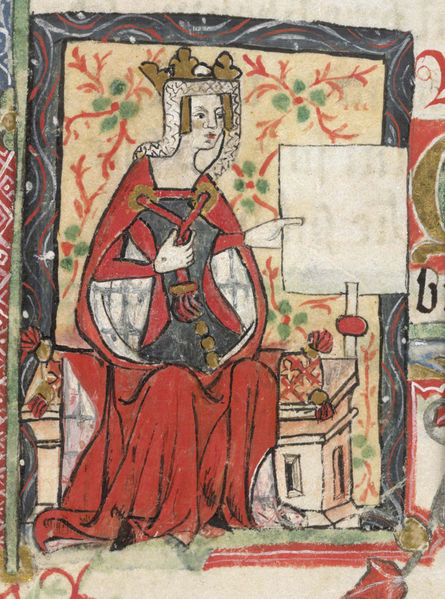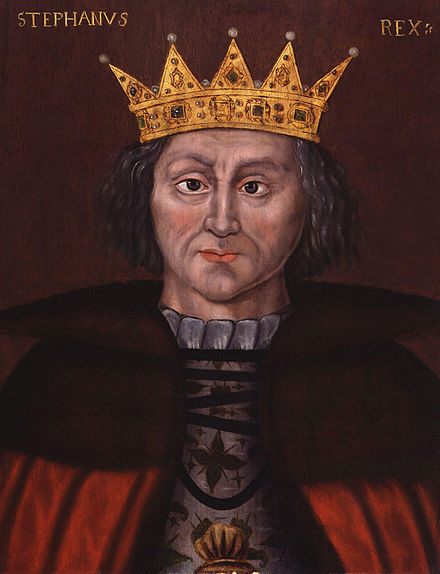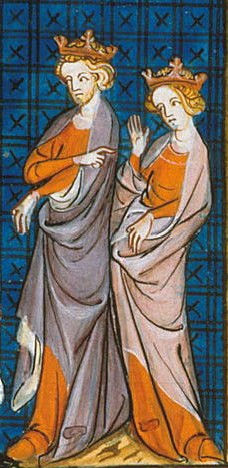The Anarchy: England's first civil war
- Christopher Riley

- Jul 29, 2020
- 7 min read
Updated: Aug 10, 2020
The English civil war of the 1640's is well know throughout the world but, it wasn't the first time war had broken out between governmental factions. England was thrown into war and a break down of law on order after death of William, the only male heir of Henry I, leaving ether his Daughter Matilda, or his nephew Stephen of Blois to inherit the throne. What followed was known simply as, 'The Anarchy.'

Empress Matilda, from “History of England” by St. Albans monks (15th century); Cotton Nero D. VII, f.7 SOURCE: British Library.
The last of the Norman Kings
The year is 1100 and Henry, the third son William the Conquerer, has inherited the crown after his brother William Rufus' death. Henry would go on to have two legitimate children named William and Matilda. Henry also had twenty four illegitimate ones, which was not an abnormal practice for monarchs but, twenty four children to mistresses is an astonishing 'achievement' non the less. At the age of just 12, Matilda, a head strong and arrogant young princess, was quickly married off to the Holy Roman Emperor Henry V (not the Henry V who fought at Agincourt) where she would act as Empress until his death in 1025. Empress Matilda then went on to marry Geoffrey V, Count of Anjou but more on him later. William 'the Ætheling' was heir apparent to the throne of England and was made Duke of Normandy, a title held in name more than practice and by 1019, was married to Matilda of Anjou (not hit sister.)
Henry’s reign was on the up and up, his marriage to Matilda (yes, another one) daughter of the recently dead king Malcom III of Scotland, helped to ease tensions across the border and had crushed a rebellion by his brother Robert, rejoining England and Normandy under one crown but then, in 1120, one of the many turning point moments in history happened.
The White Ship disaster
On 25 November 1120, Henry was in Normandy with his 17 year old son, William, planning on returning to England taking the short trip over the Channel when William, decided to stay and get drunk with some of his illegitimate brothers. The now infamous vessel that William was to return to England on was called the White Ship, a relative luxury liner with enough space for over 300 guests. The partying went on well into the night but eventually, the ship left Barfleur with the drunk prince and his friends on board. The ship barely made it out of the port, running into a submerged rock sinking the ship and throwing all 300 guests into the sea. Being able to swim wasn’t the primary skill it is today so and unfortunately, all but two of the guests drowned including the heir, William. According to the historian Orderic Vitalis, the captain of the ship was one of the guests that survived but upon finding out that the future King was amongst the dead, he let himself drown, not willing to live with the shame. Upon hearing the news of his only son’s death, the king was obviously distraught. Orderic Vitalis writes ‘So sudden was the shock, and so severe his anguish, that he instantly fell to the ground, but being raised up by his friends, he was conducted to his chamber, and gave free course to the bitterness of his grief.’ Other than the obvious death of a son, the White Ship disaster robbed England of her heir, throwing the succession into doubt. The tragedy that befell the King and his family was made worse because of what it meant for the succession. Henry I had no legitimate male children to replace William with and in the 12th century, females rarely succeed their fathers.
A princess promised?
With only Matilda left, Henry went against the grain and pronounced her heir to the throne of England. Most of the English and Norman nobility, some what reservedly, supported Matilda's claim but, upon Henry's death in 1135, a new player entered the game. Henry had a favourite nephew, Stephen of Blois, who had grown up around Henry being gifted lands in Kent and Boulogne. Stephen swore to honour his request to see his Daughter, Matilda on the throne but, It didn’t take long for Stephen to sail from Boulogne and with papal authority, claim England for himself. By offering up England to the Pope in exchange for support, Stephen gave the Pope control over the choosing and appointing archbishops and other members of the clergy, a small price to pay for an entire kingdom but, it was not to end well. The next two decades would be known as ‘The Anarchy’ in which Stephen, now King of England, would continue to fend off attempts by Matilda to claim her birthright.

King Stephen by Unknown artist oil on panel, 1597-1618 SOURCE: National Portrait Gallery 4980(3)
the forgetful King Stephen
Stephen's reign got going as well as could be imagined, with barons who had previously supported Matilda in rebellion against Stephen's usurpation, and the Welsh, who had troubled his uncle Henry were back in the mood for a fight. Stephen was, unlike his cousin Matilda, mild mannered and somewhat timid leading to struggles consolidating power, relying on Flemish mercenaries to police his now fractured kingdom. In 1139, The empress Matilda, who had been in exile in France, had invaded the south of England with help from her half brother (an illegitimate child of the late king Henry I) Robert Earl of Gloucester. Both Matilda and Stephen's armies were made up mainly, of mercenaries from France, Flanders and other European states meaning both claimants struggled with popularity from the native English. Stephen’s Flemish mercenaries were quick to get paid then disperse into the English countryside to cause trouble robbing and destroying property. The civil war that would follow, began with small sieges and skirmishes with neither side able to make serious gains. With Matilda gaining favour in the south east of the country, around the Thames Valley and Stephen in the south west, the conflict became more of a waiting game or attritional struggle rather than all out civil war.
The major turning point happened in 1141 at Lincoln, when Stephen’s forces were met with Robert Earl of Gloucester’s men. There is little known about the details of the battle, with roughly 1000 men on each side and Stephen having much less cavalry than the ‘rebels’ had we can assume it wasn’t pretty. Gloucester’s army was made up of disinherited Lords and several Welsh princes ready to take their fight directly to the source. The result of the battle was certainly a victory for the Empress’s cause, and a captured Stephen who was sent to the castle at Bristol. With Stephen in chains, Matilda was about to be crowned Queen of England but then the mob turned on her and she had to flee herself leading to the capture of the Earl of Gloucester. With both Stephen and Gloucester in chains, a stalemate was reached leading to both men being exchanged for each other putting both sides back to square one. Stephen set about getting his revenge on his cousin and almost succeeded in capturing Matilda but, both sides were unable to make a decisive move.
A Plantagenet future
The war would continue for years, with barons in the north of England carving up vast territories for themselves in the absence of any strong legal presence to stop them, and law in the kingdom breaking down to a point where there was little in form of protection from ravaging groups of mercenaries, and wayward soldiers. In the mid 1140’s, Matilda’s Husband, Geoffrey ‘Plantagenet’ who controlled the county of Anjou, invaded Normandy and conquering the Duchy, giving his wife a place to escape to and, their son a Dukedom. Reunited with her teenage son Henry, they set about invading England and meet up with lords loyal to the cause. Several attempts were made by Henry who had started to show a real aptitude for warfare and in 1153, accompanied by his new wife Eleanor of Aquitaine, landed in England and took vast swaths of land in the north and midlands, reducing Stephen's grip on the country.

Matilda’s son, the future Henry II, with his wife Eleanor of Aquitaine, from a 14th century manuscript.
Royal 16 G VI f. 343v. SOURCE: justhistoryposts.com
With the war going terribly, and the country in financial ruin from almost two decades of fighting, Stephen knew that the only way he would be able to keep his crown, was to make Henry his heir. swearing oaths to each other, Henry was made heir to the throne of England and with his lands in France, through his father and wives vast spheres of influence, made him one of the most powerful men in Europe. Luckily for Henry, and England, Stephen died soon after the peace was reached leaving Henry to take the throne in December of 1154.
The kingdom was in dire need of someone to take control and fix the financial situation left by Stephen and Matilda's conflict. Henry would have to spend the first few years securing not only his borders but, rogue lords who took the opportunity presented by The Anarchy, to seize castles and land with The Anglo-Saxon Chronicle claiming that 'there was nothing but disturbance and wickedness and robbery.'
The Empress was never able to claim her birth right but, was a rare example in the early middle ages of a women who was more than happy to go toe to toe with her male equivalents and, become a queen (or empress in her case) in her own right. Henry II and Matilda, or Maude as she was sometimes known as, would set the mould for English Monarchs over the next few centuries. Their famous arrogance and ruthlessness that defined them was Matilda's biggest asset and also to be her eventual downfall. A notoriously proud and sometimes, overbearing queen she believed, quite rightly, in her right to ascend to the throne upon her fathers death. Stephen of Blois is a somewhat forgotten king, known simply as the man who claimed a throne over his strong willed cousin but, the effects of The Anarchy sent shockwaves through the centuries in part, leading to the signing of the Magna Carter and the barons war, some sixty years later.
I hope you enjoyed this and would love to hear what you think, please leave me a comment and follow me on Instagram @chrisriley_ for more medieval history!
As always, thanks for Reading.






Comments